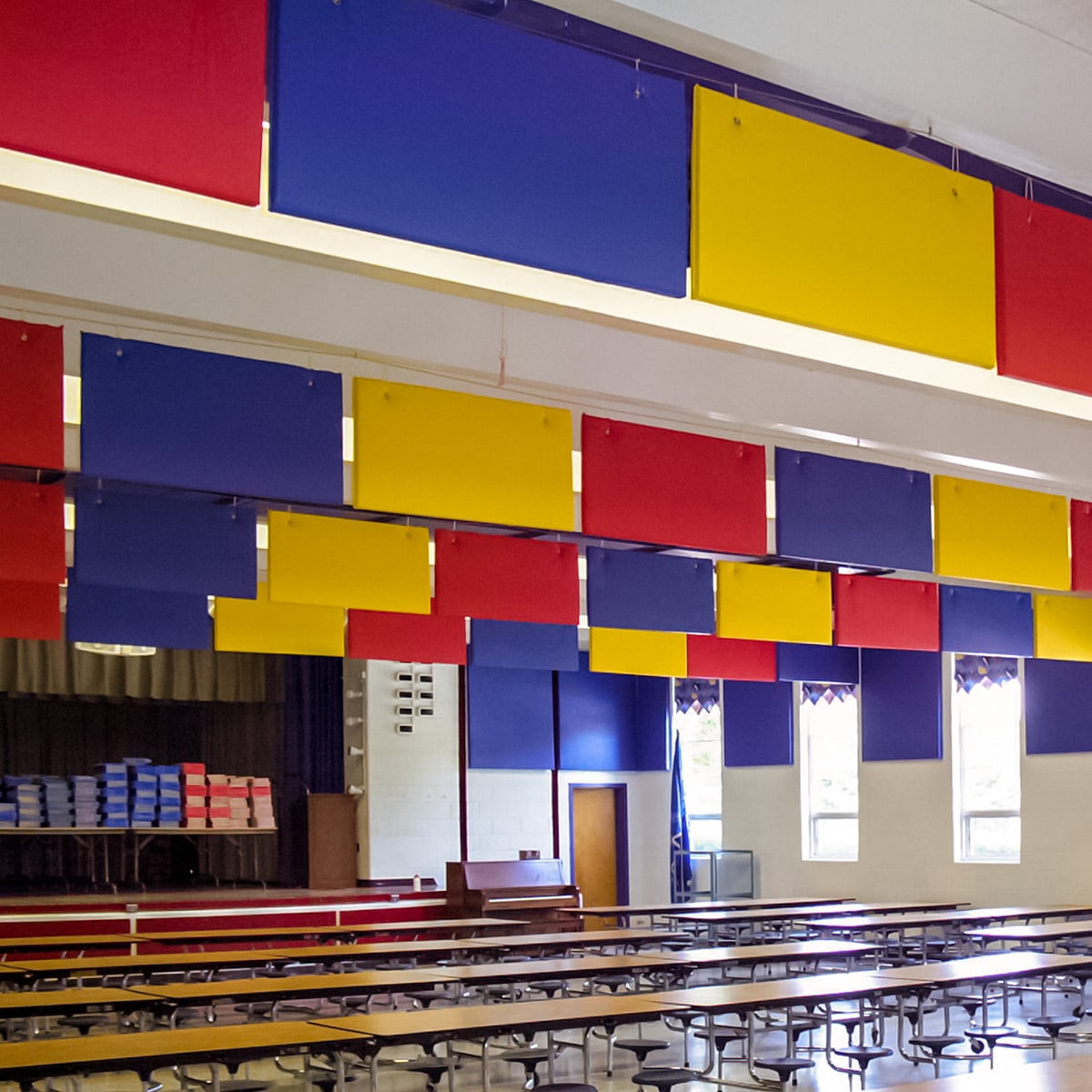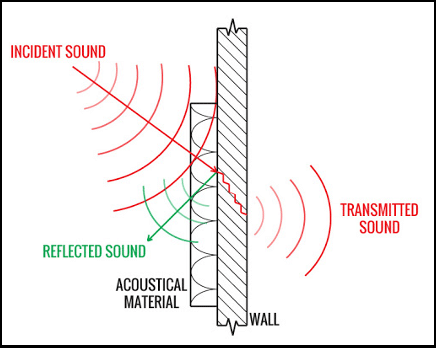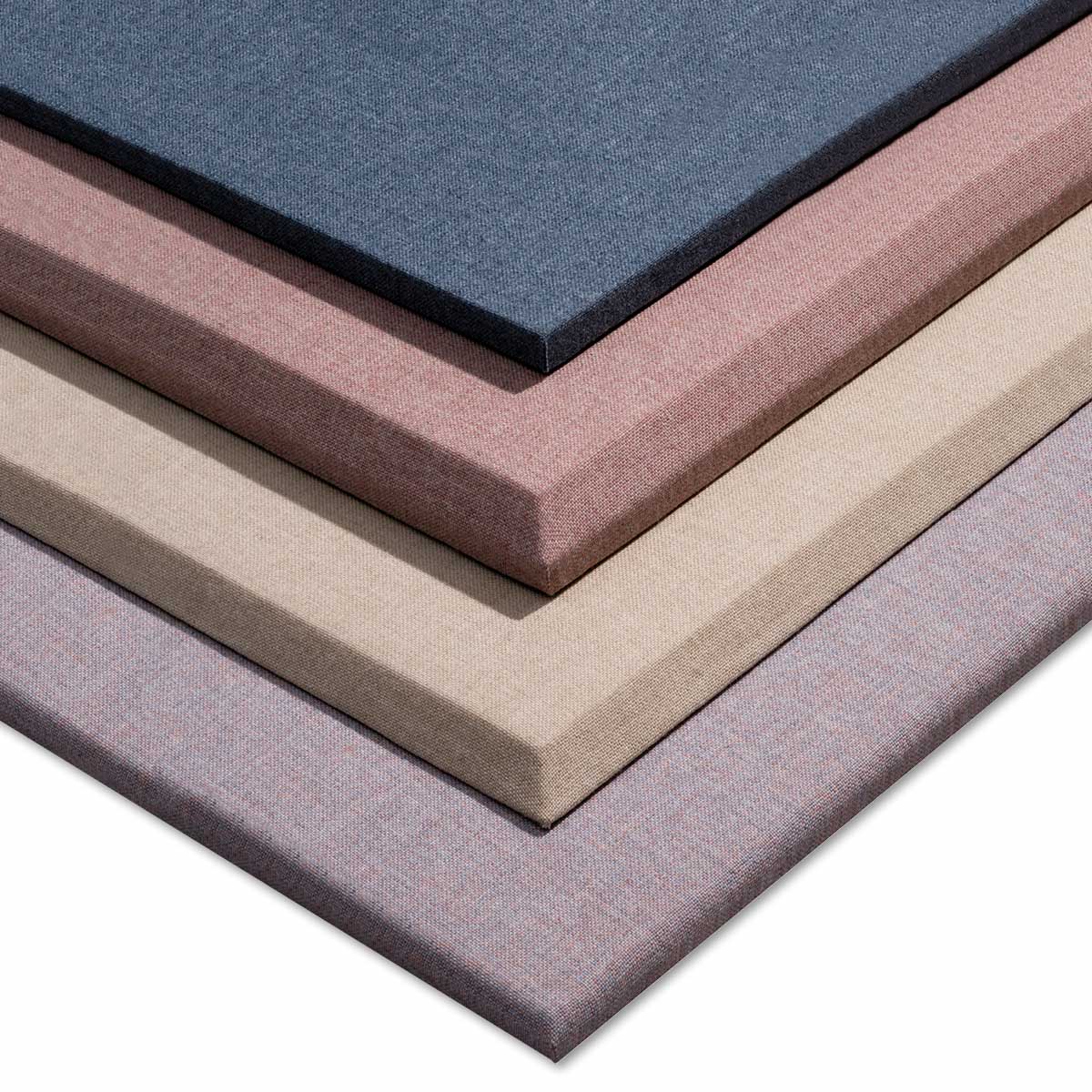You’d think I’d get tired of explaining the difference between soundproofing and sound absorption, but I never do.
It’s the most important thing to understand when it comes to acoustics and properly treating your space. It is the beating heart of acoustical solutions and absolutely critical to understand so I can help you find the products you are actually looking for.
Let’s understand soundproofing and sound absorption once and for all!

The AlphaEnviro® PVC baffles and panels provide a colorful and effective way to improve the room acoustics in this cafeteria at Mechanicsville Elementary School.
Understanding Sound Waves and How They Work
To begin, let’s properly understand what exactly sound is. Hearing is one of our five main senses for a reason: our environment on Earth is full of sounds and they impart fundamentally important information to most organisms, and all of those of great intelligence, like us. Long ago, before civilization, hearing sounds was critical to survival.
The rustle of grass and leaves while on a hunt in the woods, the heavy footfalls of a large predator near camp. At every juncture since the beginning, sounds have been important to our progression, from survival to language and communication to the wonder of music.
No matter the sound, they are all the same thing: mechanical waves propagating through a medium. The easiest example to understand this concept is when a rock is thrown into a still pond. From where the rock breaks the water, a wave is created. The rock’s movement (energy) vibrates the medium (the water) and the vibrations move outward through the medium. Although sound does move through water, air is the medium we are most familiar with when it comes to sound. When we speak, our vocal cords cause a vibration that moves through the medium of air.
This is only possible because air is made up of particles and the vibration—sound—happens because it is traveling and bouncing through all of those particles. A vacuum is when there is no air, so no particles, like most of space. Because there is nothing to bounce off of, or to carry the vibration, there is no sound.
Why Sounds Are Different
Generally speaking, we differentiate between sounds because of differing aspects of sound waves, namely the amplitude (the height of the wave) and the frequency (how many wavelengths fit into a given unit of time). This can get rather complicated, so let’s keep it as simple as possible:
The amplitude of a sound wave = the intensity of the sound, or how loud it is
The frequency of the sound wave = the pitch, or what it sounds like
Low sounds have a very long wavelength, or low frequency, while high, sharp sounds have a short wavelength, or higher frequency. No matter the frequency, all sound carries a certain amount of energy – the amplitude – and the further they travel (the more molecules in the air they bounce through), the less and less energy they have until there isn’t enough for the wave to keep going. Think about diving into a pool. When you first enter the water, you have a specific amount of energy. The reason that your body slows down while moving through the water is because the water molecules are absorbing your energy as you pass through the medium. This is how sound works. The difference between a shout and a whisper is just initial energy. Because a whisper has so little, it doesn’t take very long for the air molecules that the whisper is traveling through to take away all of its energy. A shout, on the other hand, has a lot more energy, and therefore can travel much further (vibrate through more air molecules) before it eventually weakens.
Now that we understand what sound is and how it works, let’s unfold the difference between soundproofing and sound absorption.
The Difference Between Soundproofing vs Sound Absorbing

Savannah College of Art & Design utilized the custom nature of the AcoustiWall Fabric Stretch system with Whisper Fabric and our installation services to meet their high design standards as well as attain excellent acoustics in their student commons named The Hub.
While the physics of sound waves is a complicated mechanical process, soundproofing and sound absorption are thankfully easy to understand! In short:
Soundproofing = stopping sound so it cannot be heard
Sound Absorption = filtering out unwanted parts of the sound to achieve a cleaner, “better” sound
Let’s look at this in more detail:
Soundproofing
Soundproofing also goes by another, more helpful name: sound blocking. When we’re talking about soundproofing, we’re talking about stopping sound, or taking all of its energy away. I like to use the analogy of arrows and a shield. If you held up a shield when an arrow was shot at you, the shield would stop the arrow dead in its tracks. But not just any shield, a shield capable of stopping—blocking—the arrow’s energy. Holding up a t-shirt and calling it a shield is going to be a very bad idea! A piece of wood, however, will certainly stop the arrow, even if the arrowhead pierces the wood a bit. A shield made of concrete? The arrowhead will be stopped so suddenly it will likely break and the concrete will look almost as good as new. This is the difference between a good soundproofing material and a poor one.
Soundproofing is simply putting up a shield against sound waves – arrows – and blocking them so that they cannot be heard beyond the shield. We soundproof rooms so that the sounds we create inside of them cannot escape beyond the room, and/or because we do not want external sounds to enter the room.
Sound Absorption

Sound Absorption and Transmission
The terms can be tricky once we understand the physics of sound waves because technically, a soundproofing material is absorbing the energy of the sound wave to stop it, but that is not what we mean by sound absorption. Sound absorption in acoustics means filtering the sound, choosing certain frequencies to allow through and absorbing those we do not want. For example, a person’s voice in a cave will create a number of echoes and reverberations that will “muddy” the voice and make it hard to hear. If you lined the cave with sound absorbing material, the echoes and reverberations would be absorbed, so that you would only hear the voice as it was supposed to be heard.
In essence, sound absorption is making sound cleaner and better. You may have noticed all of the panels hanging up on the walls in a movie theater. Those are there to absorb echo and reverberation so that the expertly-crafted sound coming from the speakers can be both loud and clear.
How to Effectively Soundproof: Know Your Needs
In order to effectively soundproof a space, you must first determine your goals to know what lengths you must go to with material selection and potentially renovation. For many applications, dramatically reducing sound rather than eliminating it completely is all that is needed to achieve your goals. This situation might mean you can rely on non-invasive soundproofing products, rather than getting behind walls and under floors to achieve complete soundproofing.
Here are a number of helpful articles that show the different kinds of soundproofing strategies and materials are chosen based on your project:
- How To Soundproof A Condo
- The Best Soundproofing Wall Panels For Bedrooms
- How To Soundproof A Bathroom
- How To Soundproof A Drum Room Or Booth
- Soundproofing Walls And Floors With IIC Floor And STC 70 Wall Assemblies
Sound Absorption Tactics and Materials

AlphaSorb® Fabric Wrapped Acoustic Panel Edge Styles – Square, Beveled, Mitered, Rounded (not available)
Sound absorption can essentially be employed anywhere there is sound that needs to be reduced. Some of the common applications I see from customer requests include churches, offices, home theaters and podcasting studios, music and radio studios, gymnasiums, restaurants, and museums. Especially with large rooms (like our cave analogy above), applying proper sound absorption can clean up the sound and make it sound clear.
We utilize a number of acoustic panels, ceiling clouds, tiles, and bass traps to achieve this and design a solution specific to your unique needs. Here are some articles from a variety of applications to help you get an idea of what’s possible:
- 8 Ways To Reduce Background Noise In A Call Center And Improve Acoustics
- Enhancing Audio With Home Theater Acoustic Panels
- Optimizing Office Acoustics with Sound Absorption Techniques
- How to Silence A Noisy Restaurant
Acoustical Solutions: Our Name Says It All
I hope this article helps you to finally understand the difference between soundproofing and sound absorption. At Acoustical Solutions, our core mission is to provide outstanding products to meet these two needs to make sound in our world as separated and/or clean as we hope for. Give me a call today and I’d be happy to discuss your unique needs and develop a plan to soundproof and/or provide sound absorption to achieve your goals!
To learn more about how Acoustical Solutions can solve your noise control problems, use our contact form, call one of our Acoustical Sales Consultants at (800) 782-5742, or visit us on the web at acousticalsolutions.com.